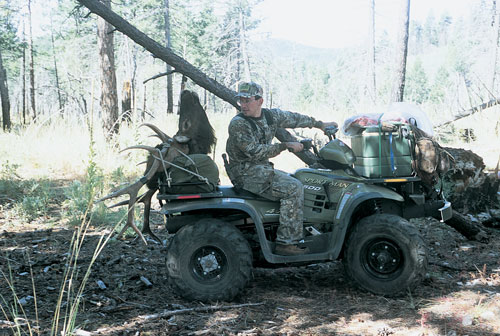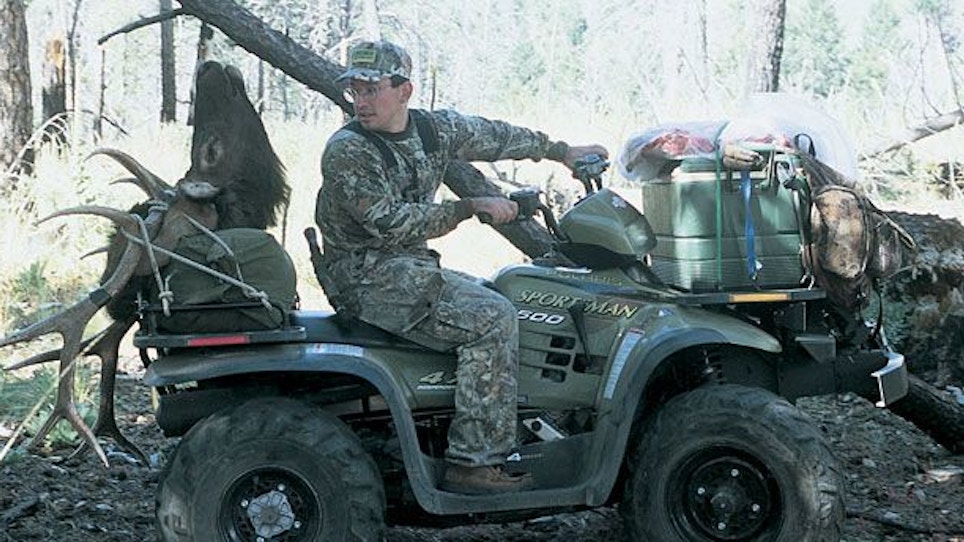Previously: Curse Of The Bruin
Pre-Rut Tactics
 This was my first pre-rut elk hunt, and it taught me a lot. In the first couple weeks of September, there isn’t a lot of bugling like later in the month. As the week progresses, you begin to hear more bugles in the early morning and late evening, but still not a lot of roaring back and forth like you hear in the peak of the rut. As a result, you may find cow calling is a lot more common and effective in getting a response. From a half-hour after sunrise to a half-hour before sunset, cow calls may be the only elk vocalizations you will hear.
This was my first pre-rut elk hunt, and it taught me a lot. In the first couple weeks of September, there isn’t a lot of bugling like later in the month. As the week progresses, you begin to hear more bugles in the early morning and late evening, but still not a lot of roaring back and forth like you hear in the peak of the rut. As a result, you may find cow calling is a lot more common and effective in getting a response. From a half-hour after sunrise to a half-hour before sunset, cow calls may be the only elk vocalizations you will hear.
Many hunters like to go elk hunting in the rut so they can hear the bulls bugling, and I’ll admit I enjoy that spine-tingling whistle as much as the next guy. However, as a bowhunter, when I go elk hunting, I like to kill a bull, and it has been my experience that the early season is the time where I have the best chances. I can hear bulls bugle on the Outdoor Channel in my living room.
The other big difference between hunting this timeframe and the rut is that when a bull answers your calling, he typically won’t be headed in your direction. In the early season, you can listen for bugles to determine the areas holding the elk. If you cow call and have a bull answer, chances are he isn’t coming to you, but he will stop what he is doing and look in your direction. When you have a bull answer, don’t continue calling like you would during the rut. Instead, try to home-in on the bull’s location, moving to where you think you will be able to see the bull and decide if he is the one you want. If you think you are getting close to the bull’s location but you still haven’t spotted him, then it’s time to call again to see if he is still around.
One thing about hunting the Southwest during in early September is that typically, the mature herd bulls are not the ones out gathering up cows. Usually, the younger, satellite bulls gather cows and do the majority of the bugling that time of year. The big boys are usually alone, but in the vicinity, thrashing brush, making wallows, and generally keeping watch on the younger bulls while preparing for the combat to come.
When you spot a decent bull with a herd of cows, it might be worth your while to glass the surrounding country before setting your sights on him.
Bears Again
Arriving full of anticipation about ambushing at waterholes, we were in for yet another disappointment. The drought was so severe that ponds and water tanks holding the limited water were continually visited by numerous bears—not good when you’re after elk or mule deer. The parched terrain made still-hunting difficult and slow stalking more critical than ever. It was a tough hunt, but there are lots of elk in the country Milligan Brand has leased. I spotted several good bulls and actually passed up shot opportunities at three different ones in the 240- to 265-inch class. I was determined to get something bigger than the 280 I shot in 1999.
The last morning of my hunt, I decided to go back into an area where I had seen several different groups of elk. By that time in my hunt, I figured if I couldn’t spot a good bull, I might be able to fill my tag with a cow so I could take home some meat. I arrived in the area I wanted to hunt just as dawn was breaking. The air was cool and crisp and I heard bugles in several directions as I approached the top of the ridge where I wanted to glass. Of all the bugles I heard, there was one in particular that caught my attention. It was a deep guttural growl, followed by an ear-piercing whistle that seemed to linger in the air for an eternity. I had to get a look at the critter making this sound.
As the early morning light filtered its way into the canyon I was overlooking, I began to make out the silhouettes of elk. My Leicas focused in on a nice 6x5 that I had passed a couple of days earlier. I knew he wasn’t making the sound that had piqued my interest. When it got light enough to see well, I made a couple of cow calls. Just as I finished the second mew, another bull answered. He was an old herd bull that was now thrashing brush directly below me about 300 yards from the herd that held the 6x5.
When the 6x5 bugled, I cow-called, and the old bull stepped out of the brush nearly causing me to swallow my diaphragm. He was a massive 6x6. To add insult to injury, he looked in my direction and bugled in my face just for good measure. As he walked into the edge of the meadow, the 6x5 quickly drove his cows across the valley, up the opposite ridge and out of sight over its crest.
After an hour of cat-and-mouse with the monarch, I managed to get around him so the wind was right. In another 45 minutes I got ahead of him and was waiting at full draw when he stepped into an opening between two patches of brush. My arrow found its mark and 75 yards later I was admiring the regal beast laying on the point of a ridge with the sun glinting off his massive beams.
In the early season, before the bulls really get fired up, many times success can hinge on the weather. When the weather turns nasty making waterholes ineffective, you can still fill your tag if you know what to do when you have to go get ’em!
Next: Early-Season Tips






